java的10種排序演演算法範例
2022-06-30 18:00:42

推薦學習:《》
1.氣泡排序(Bubble Sort)

import java.util.Arrays;//氣泡排序public class BubbleSort_01 {
public static void main(String[] args) {
int a[]={3,44,38,5,47,15,36,26,27,2,46,4,19,50,48};
//記錄比較次數
int count=0;
//i=0,第一輪比較
for (int i = 0; i < a.length-1; i++) {
//第一輪,兩兩比較
for (int j = 0; j < a.length-1-i; j++) {
if (a[j]>a[j+1]) {
int temp=a[j];
a[j]=a[j+1];
a[j+1]=temp;
}
count++;
}
}
System.out.println(Arrays.toString(a));//[2, 3, 4, 5, 15, 19, 26, 27, 36, 38, 44, 46, 47, 48, 50]
System.out.println("一共比較了:"+count+"次");//一共比較了:105次
}}氣泡排序的優化1:
import java.util.Arrays;public class BubbleSort1_01 {
public static void main(String[] args) {
int a[]={3,44,38,5,47,15,36,26,27,2,46,4,19,50,48};
int count=0;
for (int i = 0; i < a.length-1; i++) {
boolean flag=true;
for (int j = 0; j < a.length-1-i; j++) {
if (a[j]>a[j+1]) {
int temp=a[j];
a[j]=a[j+1];
a[j+1]=temp;
flag=false;
}
count++;
}
if (flag) {
break;
}
}
System.out.println(Arrays.toString(a));// [2, 3, 4, 5, 15, 19, 26, 27, 36, 38, 44, 46, 47, 48, 50]
System.out.println("一共比較了:"+count+"次");//一共比較了:95次
}}2.選擇排序(Select Sort)

import java.util.Arrays;//選擇排序:先定義一個記錄最小元素的下標,然後迴圈一次後面的,找到最小的元素,最後將他放到前面排序好的序列。public class SelectSort_02 {
public static void main(String[] args) {
int a[]={3,44,38,5,47,15,36,26,27,2,46,4,19,50,48};
for (int i = 0; i < a.length-1; i++) {
int index=i;//標記第一個為待比較的數
for (int j = i+1; j < a.length; j++) { //然後從後面遍歷與第一個數比較
if (a[j]<a[index]) { //如果小,就交換最小值
index=j;//儲存最小元素的下標
}
}
//找到最小值後,將最小的值放到第一的位置,進行下一遍迴圈
int temp=a[index];
a[index]=a[i];
a[i]=temp;
}
System.out.println(Arrays.toString(a));//[2, 3, 4, 5, 15, 19, 26, 27, 36, 38, 44, 46, 47, 48, 50]
}}3.插入排序(Insert Sort)
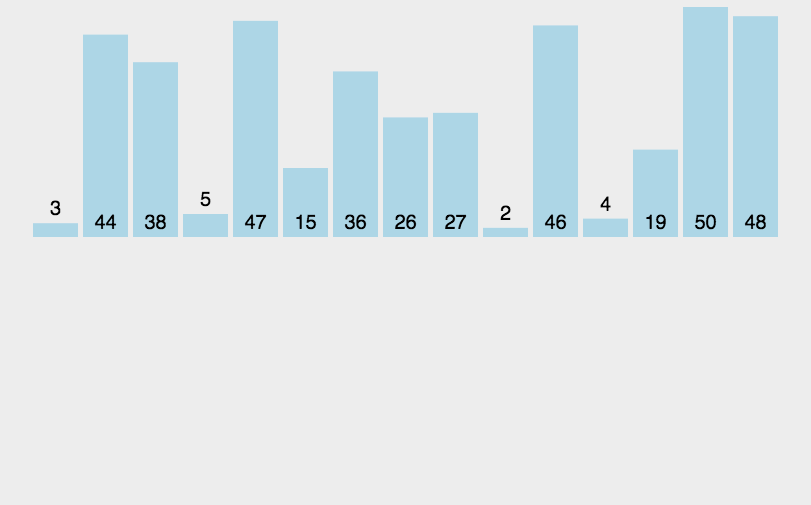
import java.util.Arrays;//插入排序:定義一個待插入的數,再定義一個待插入數的前一個數的下標,然後拿待插入數與前面的陣列一一比較,最後交換。public class InsertSort_03 {
public static void main(String[] args) {
int a[]={3,44,38,5,47,15,36,26,27,2,46,4,19,50,48};
for (int i = 0; i < a.length; i++) { //長度不減1,是因為要留多一個位置方便插入數
//定義待插入的數
int insertValue=a[i];
//找到待插入數的前一個數的下標
int insertIndex=i-1;
while (insertIndex>=0 && insertValue <a[insertIndex]) {//拿a[i]與a[i-1]的前面陣列比較
a[insertIndex+1]=a[insertIndex];
insertIndex--;
}
a[insertIndex+1]=insertValue;
}
System.out.println(Arrays.toString(a));//[2, 3, 4, 5, 15, 19, 26, 27, 36, 38, 44, 46, 47, 48, 50]
}}4.希爾排序(Shell Sort)
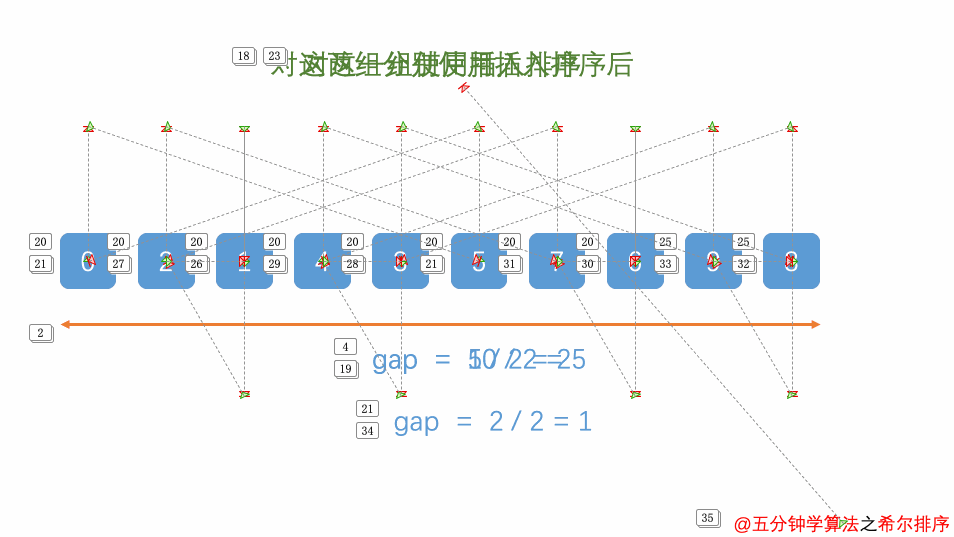
import java.util.Arrays;//希爾排序:插入排序的升級public class ShellSort_04 {
public static void main(String[] args) {
int a[]={3,44,38,5,47,15,36,26,27,2,46,4,19,50,48};
int count=0;//比較次數
for (int gap=a.length / 2; gap > 0; gap = gap / 2) {
//將整個陣列分為若干個子陣列
for (int i = gap; i < a.length; i++) {
//遍歷各組的元素
for (int j = i - gap; j>=0; j=j-gap) {
//交換元素
if (a[j]>a[j+gap]) {
int temp=a[j];
a[j]=a[j+gap];
a[j+gap]=temp;
count++;
}
}
}
}
System.out.println(count);//16
System.out.println(Arrays.toString(a));//[2, 3, 4, 5, 15, 19, 26, 27, 36, 38, 44, 46, 47, 48, 50]
}}5.快速排序(Quick Sort)
參考這篇部落格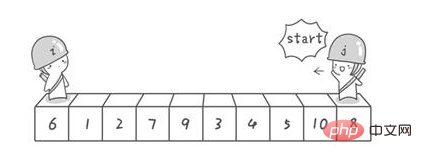
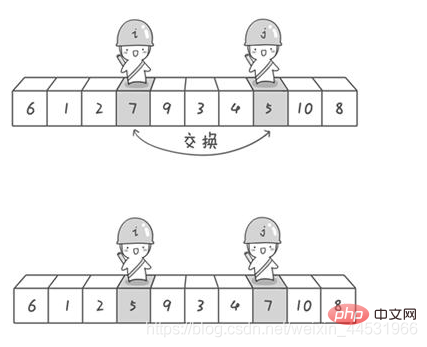
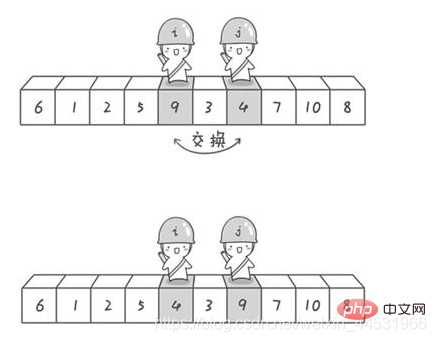
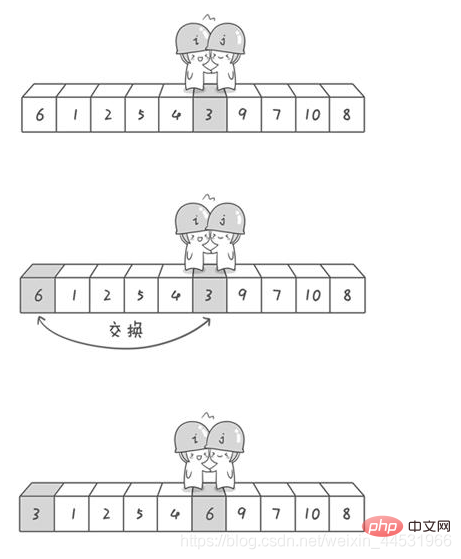
import java.util.Arrays;//快速排序:氣泡排序的昇華版public class QuickSort_05 {
public static void main(String[] args) {
//int a[]={50,1,12,2};
int a[]={3,44,38,5,47,15,36,26,27,2,46,4,19,50,48};
quicksort(a,0,a.length-1);
System.out.println(Arrays.toString(a));
}
private static void quicksort(int[] a, int low, int high) {
int i,j;
if (low>high) {
return;
}
i=low;
j=high;
int temp=a[low];//基準位,low=length時,會報異常,java.lang.ArrayIndexOutOfBoundsException: 4 ,所以必須在if判斷後面,就跳出方法。
while(i<j){
//先從右邊開始往左遞減,找到比temp小的值才停止
while ( temp<=a[j] && i<j) {
j--;
}
//再看左邊開始往右遞增,找到比temp大的值才停止
while ( temp>=a[i] && i<j) {
i++;
}
//滿足 i<j 就交換,繼續迴圈while(i<j)
if (i<j) {
int t=a[i];
a[i]=a[j];
a[j]=t;
}
}
//最後將基準位跟 a[i]與a[j]相等的位置,進行交換,此時i=j
a[low]=a[i];
a[i]=temp;
//左遞迴
quicksort(a, low, j-1);
//右遞迴
quicksort(a, j+1, high);
}}6.歸併排序(Merge Sort)
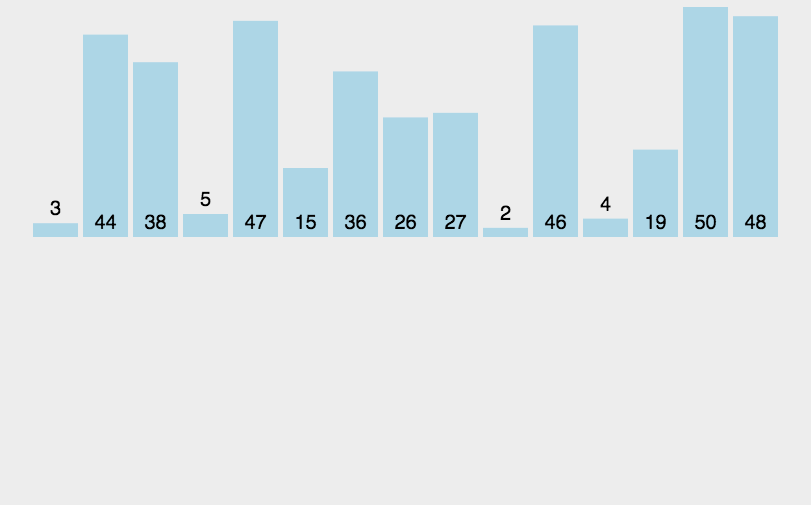
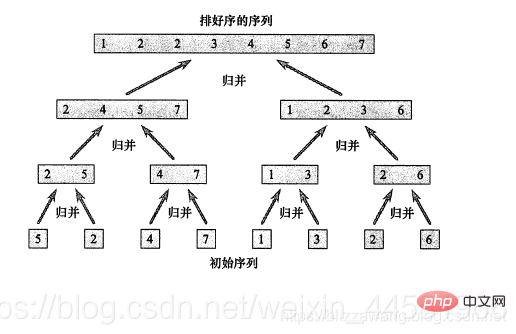
import java.util.Arrays;//歸併排序public class MergeSort_06 {
public static void main(String[] args) {
int a[]={3,44,38,5,47,15,36,26,27,2,46,4,19,50,48};
//int a[]={5,2,4,7,1,3,2,2};
int temp[]=new int[a.length];
mergesort(a,0,a.length-1,temp);
System.out.println(Arrays.toString(a));
}
private static void mergesort(int[] a, int left, int right, int[] temp) {
//分解
if (left<right) {
int mid=(left+right)/2;
//向左遞迴進行分解
mergesort(a, left, mid, temp);
//向右遞迴進行分解
mergesort(a, mid+1, right, temp);
//每分解一次便合併一次
merge(a,left,right,mid,temp);
}
}
/**
*
* @param a 待排序的陣列
* @param left 左邊有序序列的初始索引
* @param right 右邊有序序列的初始索引
* @param mid 中間索引
* @param temp 做中轉的陣列
*/
private static void merge(int[] a, int left, int right, int mid, int[] temp) {
int i=left; //初始i,左邊有序序列的初始索引
int j=mid+1;//初始化j,右邊有序序列的初始索引(右邊有序序列的初始位置即中間位置的後一位置)
int t=0;//指向temp陣列的當前索引,初始為0
//先把左右兩邊的資料(已經有序)按規則填充到temp陣列
//直到左右兩邊的有序序列,有一邊處理完成為止
while (i<=mid && j<=right) {
//如果左邊有序序列的當前元素小於或等於右邊的有序序列的當前元素,就將左邊的元素填充到temp陣列中
if (a[i]<=a[j]) {
temp[t]=a[i];
t++;//索引向後移
i++;//i後移
}else {
//反之,將右邊有序序列的當前元素填充到temp陣列中
temp[t]=a[j];
t++;//索引向後移
j++;//j後移
}
}
//把剩餘資料的一邊的元素填充到temp中
while (i<=mid) {
//此時說明左邊序列還有剩餘元素
//全部填充到temp陣列
temp[t]=a[i];
t++;
i++;
}
while (j<=right) {
//此時說明左邊序列還有剩餘元素
//全部填充到temp陣列
temp[t]=a[j];
t++;
j++;
}
//將temp陣列的元素複製到原陣列
t=0;
int tempLeft=left;
while (tempLeft<=right) {
a[tempLeft]=temp[t];
t++;
tempLeft++;
}
}
}7.堆排序(Heap Sort)
堆排序
第一步:構建初始堆buildHeap, 使用sink(arr,i, length)調整堆頂的值;
第二步:將堆頂元素下沉 目的是將最大的元素浮到堆頂來,然後使用sink(arr, 0,length)調整;
堆排序圖解:連結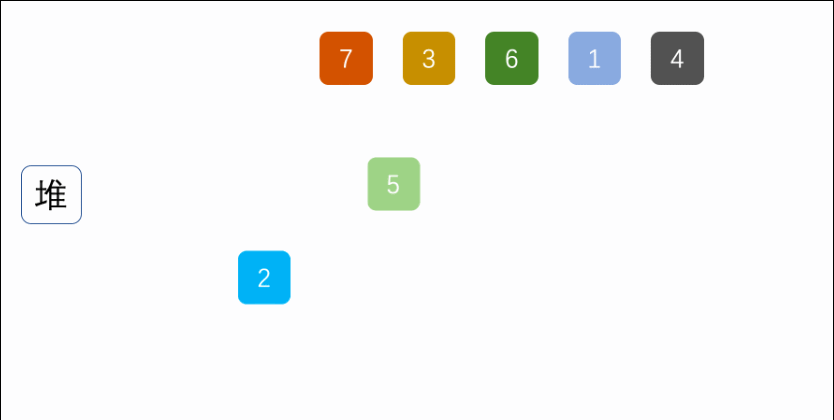
public class Heap_Sort_07 {
public static void main(String[] args) {
int a[]={3,44,38,5,47,15,36,26,27,2,46,4,19,50,48};
sort(a);
System.out.println(Arrays.toString(a));
}
public static void sort(int[] arr) {
int length = arr.length;
//構建堆
buildHeap(arr,length);
for ( int i = length - 1; i > 0; i-- ) {
//將堆頂元素與末位元素調換
int temp = arr[0];
arr[0] = arr[i];
arr[i] = temp;
//陣列長度-1 隱藏堆尾元素
length--;
//將堆頂元素下沉 目的是將最大的元素浮到堆頂來
sink(arr, 0,length);
}
}
private static void buildHeap(int[] arr, int length) {
for (int i = length / 2; i >= 0; i--) {
sink(arr,i, length);
}
}
private static void sink(int[] arr, int index, int length) {
int leftChild = 2 * index + 1;//左子節點下標
int rightChild = 2 * index + 2;//右子節點下標
int present = index;//要調整的節點下標
//下沉左邊
if (leftChild < length && arr[leftChild] > arr[present]) {
present = leftChild;
}
//下沉右邊
if (rightChild < length && arr[rightChild] > arr[present]) {
present = rightChild;
}
//如果下標不相等 證明調換過了
if (present != index) {
//交換值
int temp = arr[index];
arr[index] = arr[present];
arr[present] = temp;
//繼續下沉
sink(arr, present, length);
}
}}8.計數排序 (Count Sort)
參考連結
演演算法的步驟如下:
- 找出待排序的陣列array中最大的元素max
- 統計陣列中每個值為 i 的元素出現的次數,存入陣列 count 的第 i 項
- 對所有的計數累加(從 count中的第一個元素開始,每一項和前一項相加)
- 反向填充目標陣列:將每個元素 i 放在新陣列的第 count [i] 項,每放一個元素就將 count [i] 減去

import java.util.Arrays;public class CountSort_08 {
public static void main(String[] args) {
int[] array = { 4, 2, 2, 8, 3, 3, 1 };
// 找到陣列中最大的值 ---> max:8
int max = findMaxElement(array);
int[] sortedArr = countingSort(array, max + 1);
System.out.println("計數排序後的陣列: " + Arrays.toString(sortedArr));
}
private static int findMaxElement(int[] array) {
int max = array[0];
for (int val : array) {
if (val > max)
max = val;
}
return max;
}
private static int[] countingSort(int[] array, int range) { //range:8+1
int[] output = new int[array.length];
int[] count = new int[range];
//初始化: count1陣列
for (int i = 0; i < array.length; i++) {
count[array[i]]++;
}
//計數: count2陣列,累加次數後的,這裡用count2區分
for (int i = 1; i < range; i++) {
count[i] = count[i] + count[i - 1];
}
//排序:最後陣列
for (int i = 0; i < array.length; i++) {
output[count[array[i]] - 1] = array[i];
count[array[i]]--;
}
return output;
}}9.桶排序(Bucket Sort)
參考連結
桶排序可以看成是計數排序的升級版,它將要排的資料分到多個有序的桶裡,每個桶裡的資料再單獨排序,再把每個桶的資料依次取出,即可完成排序。
桶排序:將值為i的元素放入i號桶,最後依次把桶裡的元素倒出來。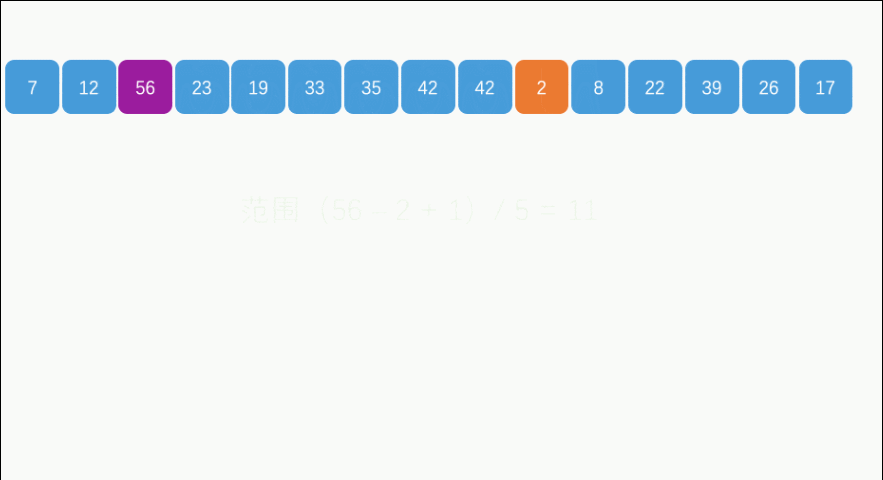 桶排序序思路:
桶排序序思路:
- 設定一個定量的陣列當作空桶子。
- 尋訪序列,並且把專案一個一個放到對應的桶子去。
- 對每個不是空的桶子進行排序。
- 從不是空的桶子裡把專案再放回原來的序列中。
public class BucketSort_09 {
public static void sort(int[] arr){
//最大最小值
int max = arr[0];
int min = arr[0];
int length = arr.length;
for(int i=1; i<length; i++) {
if(arr[i] > max) {
max = arr[i];
} else if(arr[i] < min) {
min = arr[i];
}
}
//最大值和最小值的差
int diff = max - min;
//桶列表
ArrayList<ArrayList<Integer>> bucketList = new ArrayList<>();
for(int i = 0; i < length; i++){
bucketList.add(new ArrayList<>());
}
//每個桶的存數區間
float section = (float) diff / (float) (length - 1);
//資料入桶
for(int i = 0; i < length; i++){
//當前數除以區間得出存放桶的位置 減1後得出桶的下標
int num = (int) (arr[i] / section) - 1;
if(num < 0){
num = 0;
}
bucketList.get(num).add(arr[i]);
}
//桶內排序
for(int i = 0; i < bucketList.size(); i++){
//jdk的排序速度當然信得過
Collections.sort(bucketList.get(i));
}
//寫入原陣列
int index = 0;
for(ArrayList<Integer> arrayList : bucketList){
for(int value : arrayList){
arr[index] = value;
index++;
}
}
}}10.基數排序(Raix Sort)
我們假設有一個待排序陣列[53,3,542,748,14,214],那麼如何使用基數排序對其進行排序呢?
首先我們有這樣的十個一維陣列,在基數排序中也叫桶。用桶排序實現。 第一輪,以元素的個位數進行區分:[542,53,3,14,214,748]
第一輪,以元素的個位數進行區分:[542,53,3,14,214,748] 第二輪,以元素的十位數進行區分:[3,14,214,542,748,53]
第二輪,以元素的十位數進行區分:[3,14,214,542,748,53] 第三輪,以元素的百位數進行區分:[3,14,53,214,542,748]
第三輪,以元素的百位數進行區分:[3,14,53,214,542,748]
import java.util.Arrays;public class RaixSort_10 {
public static void main(String[] args) {
int[] arr = { 53, 3, 542, 748, 14, 214 };
// 得到陣列中最大的數
int max = arr[0];// 假設第一個數就是陣列中的最大數
for (int i = 1; i < arr.length; i++) {
if (arr[i] > max) {
max = arr[i];
}
}
// 得到最大數是幾位數
// 通過拼接一個空串將其變為字串進而求得字串的長度,即為位數
int maxLength = (max + "").length();
// 定義一個二維陣列,模擬桶,每個桶就是一個一維陣列
// 為了防止放入資料的時候桶溢位,我們應該儘量將桶的容量設定得大一些
int[][] bucket = new int[10][arr.length];
// 記錄每個桶中實際存放的元素個數
// 定義一個一維陣列來記錄每個桶中每次放入的元素個數
int[] bucketElementCounts = new int[10];
// 通過變數n幫助取出元素位數上的數
for (int i = 0, n = 1; i < maxLength; i++, n *= 10) {
for (int j = 0; j < arr.length; j++) {
// 針對每個元素的位數進行處理
int digitOfElement = arr[j] / n % 10;
// 將元素放入對應的桶中
// bucketElementCounts[digitOfElement]就是桶中的元素個數,初始為0,放在第一位
bucket[digitOfElement][bucketElementCounts[digitOfElement]] = arr[j];
// 將桶中的元素個數++
// 這樣接下來的元素就可以排在前面的元素後面
bucketElementCounts[digitOfElement]++;
}
// 按照桶的順序取出資料並放回原陣列
int index = 0;
for (int k = 0; k < bucket.length; k++) {
// 如果桶中有資料,才取出放回原陣列
if (bucketElementCounts[k] != 0) {
// 說明桶中有資料,對該桶進行遍歷
for (int l = 0; l < bucketElementCounts[k]; l++) {
// 取出元素放回原陣列
arr[index++] = bucket[k][l];
}
}
// 每輪處理後,需要將每個bucketElementCounts[k]置0
bucketElementCounts[k] = 0;
}
}
System.out.println(Arrays.toString(arr));//[3, 14, 53, 214, 542, 748]
}}基數排序是用空間換時間的經典演演算法,當資料足夠多時,達到幾千萬級別時記憶體空間可能不夠用了,發生堆記憶體溢位
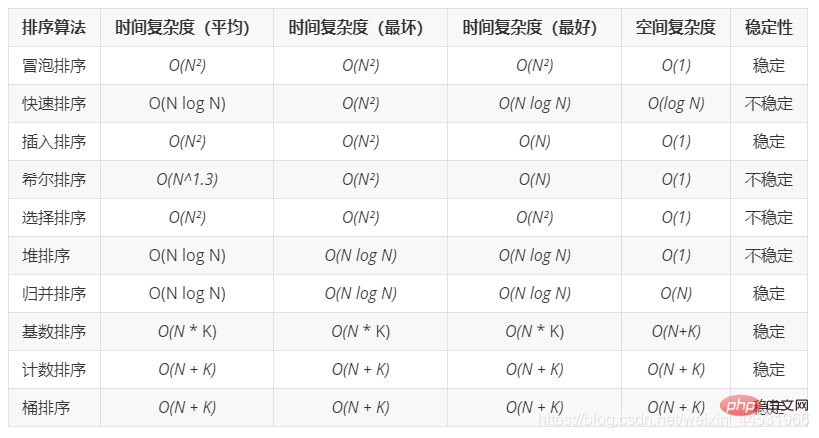
推薦學習:《》
以上就是java的10種排序演演算法範例的詳細內容,更多請關注TW511.COM其它相關文章!